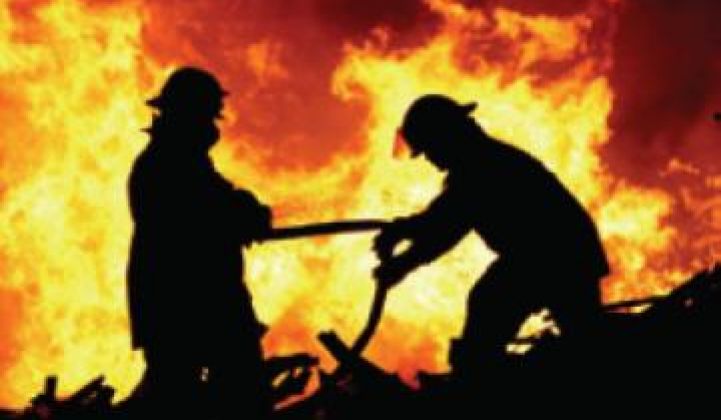VerdeXchange 2011, a business-to-business Los Angeles cleantech conference, had a strong utility presence at this year’s fourth annual gathering. Speakers from San Diego Gas and Electric (SDG&E) or Southern California Edison (SCE), the Southland’s two powerful investor-owned utilities, were on many of the conference’s business-policy panels.
In a discussion about policy and climate change, SCE’s Michael Hertel described what he called a Gordian knot. AB 32, California’s nation-leading greenhouse gas emissions reductions law, and the state’s Renewable Energy Standard (RES), requiring state utilities to obtain one-third of their power from renewable sources by 2020, will not only drive the growth of renewables capacity, Hertel said, but also necessitate new natural gas-burning power plants or result in serious power supply problems.
“Renewable power is incredibly intermittent,” Hertel said, referencing the utilities’ notorious discomfort with the variability of solar energy and wind power. He showed a graph of rising and falling wind power generation in the wind-rich Tehachapi region and another graph of solar energy variation over a twenty-four-hour period.
“As the power fluctuates, during the day or seasonally, you have to have load following generation to fill in the gaps,” Hertel said. Load following is dictated by regional and local regulation and has to be able to generate as much power as is needed without hesitation.
“The only thing we have that will work fast right now is natural gas-fired thermal capacity,” Hertel explained. Due to transmission system complexities, the new natural gas generating capacity must be built locally. But local air quality regulations prohibit that.
The utilities, according to Hertel, see no way out of the conundrum that pits well-meaning environmental forces against one another in service to opposing goals. “Every one of those goals has statutory power behind it,” he explained. “The usual solution of ‘let’s just pass a law and cut the Gordian knot’ doesn’t work because you’ve got it at the federal level, the state level, the regional level and even at the local level.” The only answer, Hertel said, is “trying to see the other person’s point of view, trying to see your interest in their interest and finding a satisfying point, not a compromise but a satisfying point, where you can move ahead.”
Hertel finished by quoting a report by California Clean Energy Future, a consortium of the California Independent System Operator (CaISO) and state energy and environmental agencies such as the CPUC, the CEC, the CARB and the state EPA. “Immediate attention and creative solutions are required.”
USC’s Daniel Mazmanian described Preparing for the Effects of Climate Change: A Strategy for California, from the California Adaptation Advisory Panel, which reported onthe urgency of untying Hertel’s Gordian knot.
“In the face of the apparent reticence of up to 40 percent of the United States public to accept climate change as a reality,” Mazmanian said, the report asks “to what extent should adaptation be center in the California agenda?” It “says we really have to think long and hard” about “the science-based options we have” and the investment opportunities in adaptation strategies for the state.
“There really needs to be cost-effective action,” Mazmanian said, “especially if we’re going to ask citizens, businesses, and communities to invest in adaptation strategies.” And incentives must be carefully targeted. “If you can’t figure out for a community why it’s in their interest to invest in adaptation,” he said, “you’re not going to get the investment.”
The report focused, Mazmanian explained, on three climate change impacts: Sea level rise, forest fires and drought. The coast, he said, can expect a one to two meter sea rise. The state could lose 80 percent of its snow pack, representing a third or more of its potable water, by the end of the century. And “most Northern Californians are only minimally aware of the extent to which” they “will be exposed to serious, huge forest fires.”
Mazmanian said the report offered three strategies: Resistance, resilience and retreat. Resistance is mitigation. Resilience is investing in preparations. Retreat is moving away from the coasts and forests and storing water. “The primary strategy agreed on,” he said, “was resilience.”
Diane Wittenberg, Chair of California’s Plug-in Vehicle Collaborative, concluded the discussion by noting “some of the most important regional efforts on climate change” and how “they’ve moved the dialogue and the action along.”
She cited six such efforts at solution-finding. The first three were the New England initiative, the Midwest alliance and the Western states alliance with Canada and Mexico on pioneering a cap-and-trade political and regulatory framework “so there’s a legitimate test of whether it works or not.”
She touted such regional efforts, she said, because focusing on regional rather than national solutions makes it “a lot easier to get your arms around a good way to approach that from a policy point of view.”
The other efforts she noted were the Climate Registry’s groundbreaking inventorying of greenhouse gas emissions in 41 states and the Canadian provinces, trade agreements designed to support green economies such as those led by former California Governor Arnold Schwarzenegger, and her own California Plug-in Vehicle Collaborative which “is really trying to make a blueprint” that will facilitate EV infrastructure implementation in the other states.
The discussion had gone from recalcitrant utility spokesman Hertel’s Gordian knot to pioneering California policy maker Wittenberg’s blueprint.



